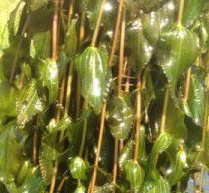Spiny pondweed
Home " Oxygen plants " Pondweed " Spiny pondweed
Spiny pondweed
This plant, also called Potamogeton Perfoliatus, is an aquatic plant that can be planted in deeper water bodies. Its leaves are slightly curled, with which it could be confused with Cruciferous Pondweed. However, when we put these species side by side, the difference is clearly visible; Creeping Pondweed is clearly less curled.
This species is found in the Netherlands mainly around the IJsselmeer. Some (peat) lakes also have a large population locally. It is a native aquatic plant. Like any member of the pondweed family, it is a good oxygen plant; photosynthesis converts sunlight into oxygen.
This Pondweed species certainly does well in the pond. However, deeper ponds (from about 1.25m) are desirable. Deeper is also possible; the plant then creates a beautiful underwater landscape. It is a rooting aquatic plant, so it is important to plant this species in a pond basket or in solid soil. It is best to use pond clay; this species does not do well in loam or clay. If your pond is suitable, it is of course also possible to plant this species directly in the soil.
Spiny pondweed Properties
- Position: Sun
- Stem length 1 to over 2 metres in the pond.
- Planting depth: 125 to 250 cm, if reasonably clear.
- Rooting aquatic plant, should be planted.
- Food-rich water is appreciated.
- It is important that the water values are up to standard. (GH, KH, pH)
Frequently asked questions
How many forests do I need in the pond?
For this species, as for other oxygen plants that 4-5 bunches per 1,000 litres of pond water give the best results. The oxygen plants can then best compete with the algae present in the pond. In this way, the water remains clear and your pond a pleasant sight.
What is the flowering time of Spiny Pondweed?
Pondweed (Potamogeton perfoliatus) blooms from June to September. The flowers are small and greenish and appear on short stalks above the water surface. Although the flowers have little visual appeal, they play a role in the reproduction of the plant. The plant is particularly appreciated for its long, translucent leaves that grow underwater and move gracefully through the water.
Is Spiny Pondweed a native aquatic plant?
Yes, Thorny Pondweed is native to the Netherlands and occurs naturally in many parts of Europe. It grows in still and slow-flowing water, such as ponds, lakes, ditches and canals. Being a native plant, Spiny pondweed is well adapted to local conditions and contributes to the biodiversity of aquatic ecosystems. The plant provides hiding places for aquatic animals and helps improve water quality.
How to plant Spiny Pondweed?
Sprawling Pondweed is best planted in shallow to moderately deep water, in a sunny to slightly shaded location. Planting is done by placing the roots in the muddy or sandy bottom of a pond or ditch, allowing the plant to become well established. You can put the plant directly into the soil or place it in a plant basket with pond soil. Make sure the plant has enough room to grow, as Spiny Pondweed can spread quite quickly under water.
How do I maintain Thorny Pondweed?
Perennial pondweed is relatively low-maintenance, but it can spread quickly. Keep a close eye on its growth, especially if you plant it in a pond where space is limited. Remove excess parts of the plant when it starts to take up too much space or overgrow other plants. Since it plays an important role in improving water quality, you don't usually need to fertilise the plant or give it special care, as long as the water is clean and clear.
Buy Spiny Pondweed?

We have good experiences with oxygen plants from De Vijvermeester. Thorny pondweed is for sale via De Vijvermeester's webshop. Here you can find beautiful bunches of high quality.
